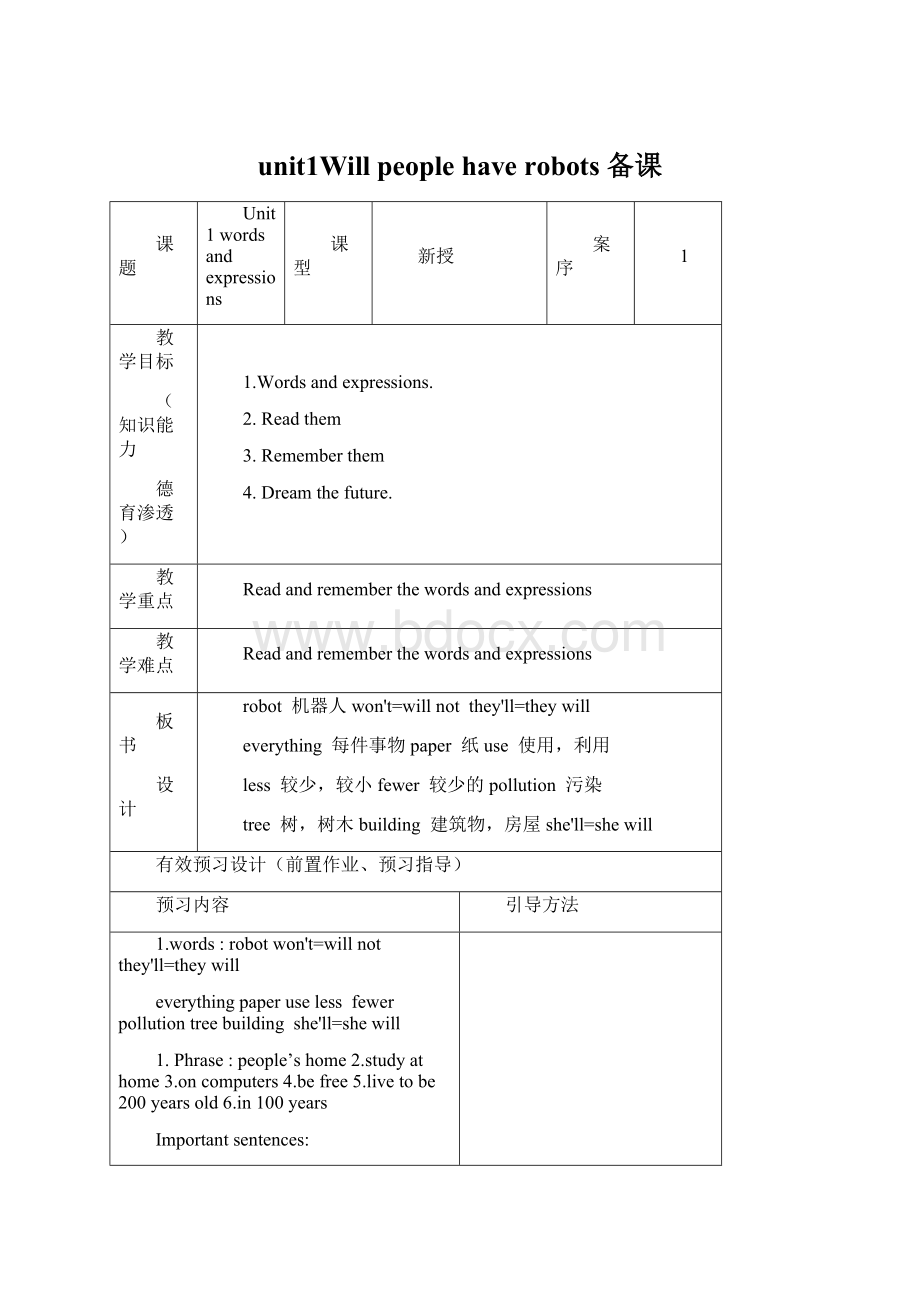unit1Will people have robots 备课.docx
《unit1Will people have robots 备课.docx》由会员分享,可在线阅读,更多相关《unit1Will people have robots 备课.docx(22页珍藏版)》请在冰豆网上搜索。

unit1Willpeoplehaverobots备课
课题
Unit1wordsandexpressions
课型
新授
案序
1
教学目标
(知识能力
德育渗透)
1.Wordsandexpressions.
2.Readthem
3.Rememberthem
4.Dreamthefuture.
教学重点
Readandrememberthewordsandexpressions
教学难点
Readandrememberthewordsandexpressions
板书
设计
robot机器人won't=willnotthey'll=theywill
everything每件事物paper纸use使用,利用
less较少,较小fewer较少的pollution污染
tree树,树木building建筑物,房屋she'll=shewill
有效预习设计(前置作业、预习指导)
预习内容
引导方法
1.words:
robotwon't=willnotthey'll=theywill
everythingpaperuselessfewerpollutiontreebuildingshe'll=shewill
1.Phrase:
people’shome2.studyathome3.oncomputers4.befree5.livetobe200yearsold6.in100years
Importantsentences:
1.Doyouthinktherewillberobotsinpeople’shomes?
2.Willpeoplehaverobotsintheirhomes?
Yes,therewill.
3.peoplewilllivetobe200yearsold.
4.Therewillbemore/less/fewerpeople/freetime
展示过程设计(以疑导学、以学定教、互动交流)
1.导入设计:
1.Greetings:
Welcometoschool.Who’sondutytoday?
Doyouenjoyyourwinterholiday?
Doyoufinishyourhomework?
2.CollecttheSs’answersandsaysomethingabouttheirpredictions.
3.HowtolearnEnglish
学习内容(展示交流、知识建构)
精讲与点拨
1.Explainsomethewords.
1)little—less+不可数名词few—fewer+可数名词
(少的)(较少的)(少的)(较少的)
2)fly—flew—flowntake—took—takenfall—fell—fallen
3)dress穿衣wear,puton,怎么穿
Wear,puton,和dress都含有“穿衣”的意思。
wear意为“穿;戴”,表示状态;puton意为“穿上”,表示动作;dress意为“穿衣服;给(某人)穿衣服”。
例如:
1.It’sbesttowearlightclothesinsuchwarmweather.
2.Heputonhiscoatatonceandranoutoftheroom.
3.Peopleoftendresscasuallyonweekends.
4.CanyouhelpmedresslittleTom?
4)suchsosuch“如此“不同
So和such都可以表示程度,意思为“如此;这样”,但用法不同。
例如:
1.ThemovieissointerestingthatIhaveseenittwice.
2.Itrainedsoheavilyyesterdayevening.
3.Don’tbeinsuchahurry.
4.Ihaveneverseensuchabeautifulpicture.
5.Itwassuchbadweatherthatwehadtostayathomeallday.
展示过程设计(以疑导学、以学定教、互动交流)
学习内容(展示交流、知识建构)
精讲与点拨
从例句1、2可以看出,so用作副词,用来修饰形容词或副词。
从例句3、4、5可知,such用来修饰名词;such一般位于不定冠词前。
用于修饰名词时,so和such的位置不同,即“such+a/an+形容词+名词”和“so+形容词+a/an+名词”。
例如:
Sheissoniceagirlthateveryonelikesherinherclass.=Sheissuchanicegirlthateveryonelikesherinherclass.她是一个非常好的女孩,全班同学都喜欢她。
特别关注:
Such既可以用来修饰不可数名词,也可以修饰可数名词,so则不能。
如果名词被much,little,many,few等表示量的形容词修饰时,其前应用so而不能用such。
如例句6。
5)cometrue实现;达到事作主语
例如:
Mydreamwillcometrue.(正确)
Iwillcometruemydream.(错误)
past—work
1.Readthenewwords.
Homework:
Readandrememberthenewwords.
反思
重建
审核认定
意见:
审核人:
月日
课题
Unit1SectionA1a—2c
课型
新授
案序
2
教学目标
(知识能力
德育渗透)
1.Wordsandexpressions.
2.will构成的一般将来时态的陈述句、否定句、疑问句及回答.
3.Therebe句型的一般将来时.
4.more,less,fewer的用法.
教学重点
1.will构成一般将来时态的句式。
2.Therebe句型的一般将来时态。
教学难点
1.will构成一般将来时态的句式。
2.Therebe句型的一般将来时态。
more,fewer,less的用法。
板书
设计
1.Peoplehaverobots?
2.Peoplewon’tusemoney.Everythingwillbefree.
3.Kidswon’tgotoschool.They’llstudyathomeoncomputer.
4.Therewilonlybeonecountry.
5.Ithinktherewillbemorepollution.
有效预习设计(前置作业、预习指导)
预习内容
引导方法
1.Lookatthepicture:
Howwilltheworldbedifferentinthefuture,100yearsfromnow?
We’regoingtotalkaboutsthin100years.
2.Readeachpredictionstotheclass.Explainthenewvocabulary.
3.Readtheinstructions.MakesureSsknowwhattheyshoulddo.
4.Doitbythemselves.
Talkabouttheanswerswiththeclass
展示过程设计(以疑导学、以学定教、互动交流)
导入设计:
1.Greetings:
Welcometoschool.
What’sthedatetoday?
Who’sondutytoday?
……
2.Dictatethenewwords.
学习内容(展示交流、知识建构)
精讲与点拨
SBPage2,1b.
5.Practisereadingthesixpredictions.
6.ReadtheinstructionstoSs.Circlethethingsyouhearontherecording.
7.Playthetapetwice.
8.Playthetapeathirdtime.Atthesametime,checktheanswers.
SBPage2,1c.
1.Payattentiontothedialogues.
2.Readthedialoguesfluently.
3.Pairwork.Workinpairstomakepredictionsaccordingtothesample.
4.Askseveralpairstosharetheirconversationstotheclass.
SBPage3,2a&2b.
1.Readthepredictions.
2.Readtheinstructionsandpointoutthesampleanswer.
3.Playthetapetwice.Sscirclethewordtheyhearineachsentences:
more,less,fewer.
4.Checktheanswers.
学生探究:
less,fewer的区别。
Post-task
1.Pointtotheexampleinthesampledialogue.Practicereading.
2.Lookatactivity2b.Groupwork:
Taketurnstomakeconversationsaboutthepredictions.
展示过程设计(以疑导学、以学定教、互动交流)
学习内容(展示交流、知识建构)
精讲与点拨
GrammarFocus:
2.Reviewthegrammarbox.Sssaythestatementsandresponses.
3.Makesummariesabout“will”,“fewer”and“less”.
Step5Practice
1.把下列短语译成英语:
1)在人们家里___2)在网上学习_________
3)免费的______4)活到200岁___
5)100年后_____6)更少的人_____
7)更少的时间__8)更多的轿车______
2.用more,less,fewer填空
1)Therewillbe________computersinthefuture.
2)Therewillbe_______animalsinthefuture.
3)Wewillhave_______freetime.
Homework:
1.Makepredictionsaboutyourselfin10years.Writedown5sentences.
2.Gooverthenewwords.
.
反思
重建
审核认定
意见:
审核人:
月日
课题
Unit1SectionA3a—4
课型
新授
案序
3
教学目标
(知识能力
德育渗透)
1.Wordsandexpressions.
2.学习一般将来时态的相关知识,学会对未来进行预测.
3.对fiveyearsago,today,infiveyears简洁回顾与展望的方式,贴近实际符合学生心理,激发学习兴趣.
教学重点
1.will构成一般将来时态的句式。
2.Therebe句型的一般将来时态。
3.Howtomakepredictions.
教学难点
1.will构成一般将来时态的句式。
2.Therebe句型的一般将来时态。
3.Howtomakepredictions.
板书
设计
1.Fiveyearsago,Sallywasinhighschool.
2.Sheplayedfootball.
3.Today,Sallyisincollege.
4.Infiveyears,Sallywillbeadoctor.
有效预习设计(前置作业、预习指导)
预习内容
引导方法
1.Gooverwhatwelearntyesterday.
2.通过三种时间的对比简略复习一般过去时与一般现在时
展示过程设计(以疑导学、以学定教、互动交流)
导入设计:
Greetingsandfreetalk.Checktheirhomework:
AsktwoorthreeSstospeakoutwhattheywrotedown.(教师作出适当的评价)
学习内容(展示交流、知识建构)
精讲与点拨
SBPage3,3a.
1.Pointtothethreepictureandsay:
ThisisSally.ThefirstpictureisSallyfiveyearsago,thesecondoneisSallynow,andthethirdoneisSallyfiveyearsinthefuture.
2.Readtheinstructions.
3.Completefillingintheblanksindividually.
4.Checktheanswers.
5.Practisereading.ThenasksomeSsreadthemout.
SBPage3,3b.
1.Lookatactivity3a.MakepredictionsaboutSally.
2.Pointtotheexampleinthesampledialogue.AsktwoSstoreadthedialoguetotheclass.
3.Practisereading.
4.Pairwork.MaketheirpredictionsaboutSally.
Post-task
1.Writeaboutyourself.
展示过程设计(以疑导学、以学定教、互动交流)
学习内容(展示交流、知识建构)
精讲与点拨
WiththehelpofthesampleofSally.Wecanwritesthaboutourselvesfiveyearsago,todayandinfiveyears.
2.Completetheworkindividually.
3.Reviewthetask.AskafewmoreSsforanswers.
Step5Exercises
3.句型转换
1)Therewillberobotsinourhome.(改为一般疑问句并作肯定回答)
2)Peoplewillusepapermoney.(变为否定句)
3)Thereismorepollutionindevelopingcountries.(改为将来式)
4.汉译英
1)娃娃们将会在家通过上网学习。
2)你认为在人们家中将有机器人吗?
3)人将活到200岁。
Homework:
Drawapictureofthecityin20years.Describeittotheclass.
.
反思
重建
审核认定
意见:
审核人:
月日
课题
Unit1SectionB1a-2c
课型
新授
案序
4
教学目标
(知识能力
德育渗透)
1.Wordsandexpressions.
2.学习一般将来时态的相关知识,学会对未来进行预测.
3.listening
教学重点
1.will构成一般将来时态的句式。
2.Therebe句型的一般将来时态。
3.Howtomakepredictions.
教学难点
11.will构成一般将来时态的句式。
2.Therebe句型的一般将来时态。
3.Howtomakepredictions.
板书
设计
1.astronauthouseapartmetcomputertrainrocketspacestation
2.Iliveinanapartment.
3.I’lllivenearhere.
4.Welivedinahouse.
5.Iworkonaspacestation.
有效预习设计(前置作业、预习指导)
预习内容
引导方法
SBPage4,1a.
1.Lookattheformandreadtheheadingstotheclass.MakesuretheSsknowwhattheymean.
2.Readthelistofsevenwords.Explainthenewwords.
3.Writeeachwordinthecorrectcolumn.Checktheanswers.
SBPage4,1b.
1.Readthewordsalreadywrittenonthechart.
Groupwork:
Thinkaboutwhatwelearnedbefore.Writesomewordsinthechartabove.
展示过程设计(以疑导学、以学定教、互动交流)
导入设计:
1.Greetings:
Welcometoschool.
What’sthedatetoday?
Who’sondutytoday?
……
3.Dictatethenewwords.
学习内容(展示交流、知识建构)
精讲与点拨
SBPage4,2a.
1.Lookatthepicturescarefully.Canyouguesswhatwe’lllisten?
Talkaboutthem.
2.Readtheinstructions.Listenandnumberthepictures1-3.
A:
Hi,I’mAlexis.
B:
Nicetomeetyou,Alexis.I’mJoe.
A:
Nicetomeetyou,Joe.DoyoulivehereinTechville?
B:
Yes,Ido.Iliveinan1acrossthestreetfromhere.
A:
Oh,really?
B:
Yes.Yes.I2nearheretoo,atSiscoSoftwareSystems.Iamacomputer3.
A:
Acomputerprogrammer?
Thatsounds4.
B:
Well,actuallyit’skindof5.Idothesamethingeveryday.
3.Playthetapetwice.Checktheanswers.
SBPage4,2b.
Thisactivityiseasy,Ithink.ForweknowtheconversationsaretalkingaboutAlexis10yearsago,todayandin10years.
展示过程设计(以疑导学、以学定教、互动交流)
学习内容(展示交流、知识建构)
精讲与点拨
1.Playthetapeandcorrecttheanswers..
2.Readtheinstructions.
3.Payattentiontothesentencesandtheverbsinthebox.
Post-task
1.Readtheinstructions.
2.Pairwork.OneisAlexis,oneisJoe.
3.Pointouttheexampleinthesampledialogue.ReadittotheSs.
4.TalkaboutJoe’slifenow,tenyearsagoandintenyears.
5.AsksomepairsofSstosaytheirdialogues.
Homework:
1.Gooverthewords.
2.写一篇50个单词左右的小短文,预测与展望未来我们的学习和生活。
.
反思
重建
审核认定
意见:
审核人:
月日
课题
Unit1SectionB3a—4
课型
新授
案序
5
教学目标
(知识能力
德育渗透)
1.Wordsandexpressions.
2.通过时间对比复习一般过去时态、一般现在时态,巩固一般将来时
3.Retellthepassage
教学重点
1.will构成一般将来时态的句式。
2.Therebe句型的一般将来时态。
3.Retellthepassage
教学难点
1.will构成一般将来时态的句式。
2.Therebe句型的一般将来时态。
3.Rete